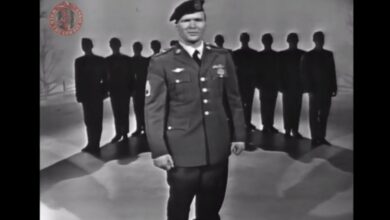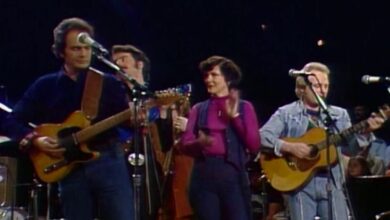Hearing Marty Haggard’s son sing his father’s song moves us to tears.
“Mama’s Hungry Eyes” is a deeply moving song that encapsulates the emotions surrounding familial love, sacrifice, and the trials of motherhood. Written and recorded by Merle Haggard in 1968, the track highlights Haggard’s exceptional storytelling ability, shaped by his own life experiences. The lyrics evoke a sense of nostalgia and warmth, serving as a heartfelt homage to his mother, who endured great challenges while raising her children alone after her husband’s untimely passing. This poignant narrative connects with many who have faced similar situations, making it a universal reflection on the struggles of motherhood.
In this touching composition, Haggard vividly portrays a mother’s longing, capturing the emotional burden borne by those who strive to provide for their families while grappling with their own difficulties. The imagery woven into the lyrics emphasizes a mother’s intense love and her unwavering resolve to care for her children, often at the expense of her own health and happiness. The raw emotions in each line resonate with listeners, highlighting themes of sacrifice, resilience, and the deep bond between mother and child.
The song’s melodic framework complements its lyrical richness, featuring straightforward yet impactful chords that highlight the storytelling. Haggard’s distinctive voice, deeply rooted in the country music tradition, lends authenticity to the piece. His emotive vocal delivery ensures that every word strikes a chord with listeners, creating a lasting impact. The combination of melody and lyrics fosters an atmosphere of empathy, encouraging listeners to reflect on their own relationships and memories.
Beyond Haggard’s original rendition, the song has been revisited by several artists, including his son, Marty Haggard. When Marty recorded his interpretation of “Mama’s Hungry Eyes,” he paid tribute to his father’s legacy while infusing the narrative with new perspectives. This reinterpretation not only honors the original work but also underscores the generational bond between father and son, bringing to light the indomitable spirit of their mother and depicting various moments that illustrate the realities of a working mother’s life.
Marty’s version introduces new lyrics that delve into the sacrifices made by his mother, granting listeners a more personal insight into her experiences. The depiction of a weary woman laboring at a truck stop, finding fleeting joy in singing to uplift her children, adds emotional depth to the narrative. This nuanced representation reveals the complexities of motherhood, showcasing both the burdens and joys intertwined in the journey of raising a family. These details foster a deeper connection with the story, evoking empathy and understanding for mothers everywhere.
The emotional resonance of “Mama’s Hungry Eyes” transcends the specific experiences of Haggard’s family, reaching audiences from all walks of life. It addresses universally relatable themes of love, struggle, and the lengths to which mothers go for their children. This broad appeal is a testament to the power of songwriting, demonstrating the timeless relevance of personal narratives that reflect deeper human truths.
Merle Haggard’s legacy is rooted in authenticity and a deep respect for the human experience. Born in 1937 in Bakersfield, California, Haggard faced numerous challenges that informed his understanding of sacrifice and perseverance, including time spent in juvenile detention. His background imbued his music with a rawness that resonated with working-class audiences, establishing him as a key figure in the Bakersfield sound, a subgenre of country music known for its honky-tonk influences and straightforward storytelling. Throughout his prolific career, Haggard produced countless hits, solidifying his place in American music history.
Haggard’s influence extends beyond his own works; countless artists have drawn inspiration from his storytelling style. His ability to weave personal experiences into his songs is a hallmark of his artistry, allowing listeners to connect with his music on a profound emotional level. By channeling his life into his art, Haggard left a legacy that speaks to the heart of American culture and the shared human experience.
Ultimately, “Mama’s Hungry Eyes” stands as a powerful tribute to the strength and complexities of motherhood. The enduring relevance of this song, along with its various adaptations, highlights the capacity of music to encapsulate and convey the essence of familial bonds. Both Merle and Marty Haggard’s contributions to the song reflect the lasting nature of love, memory, and the ties that connect generations. As audiences continue to embrace these narratives, they discover comfort in the shared experiences and emotional truths that the song embodies.
In summary, “Mama’s Hungry Eyes” holds a significant place in the country music landscape, celebrating not only the resilience of mothers but also the interconnectedness of family stories that span generations. The heartfelt expressions from Merle and Marty Haggard illustrate how music serves as a conduit for personal and collective storytelling, ensuring that the legacy of their experiences and the emotions entwined within them will continue to resonate through the years. This poignant tribute guarantees that “Mama’s Hungry Eyes” will be cherished as an integral part of the country music fabric, capturing the enduring spirit of maternal love and sacrifice.





